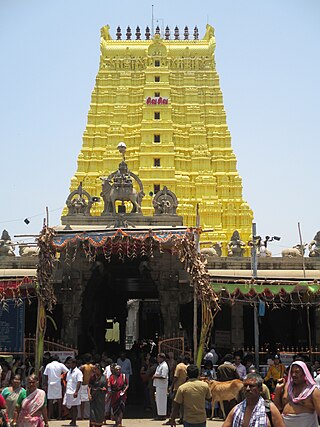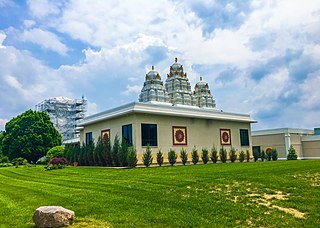
Prambanan is a 9th-century Hindu temple compound in the Special Region of Yogyakarta, in southern Java, Indonesia, dedicated to the Trimūrti, the expression of God as the Creator (Brahma), the Preserver (Vishnu) and the Destroyer (Shiva). The temple compound is located approximately 17 kilometres (11 mi) northeast of the city of Yogyakarta on the boundary between Central Java and Yogyakarta provinces.

Trimbakeshwar Shiva Temple is an ancient Hindu temple in the town of Trimbak, in the Trimbakeshwar tehsil in the Nashik District of Maharashtra, India, 28 km from the city of Nashik and 40 km from Nashik road. It is dedicated to Hindu god Shiva and is one of the twelve jyotirlingas where the Hindu genealogy registers at Trimbakeshwar, Maharashtra are kept. The origin of the sacred Godavari river is near Trimbak.
Prayer is considered to be an integral part of the Hindu religion; it is practiced during Hindu worship (puja) and is an expression of devotion (bhakti). The chanting of mantras is the most popular form of worship in Hinduism. Yoga and meditation are also considered as a form of devotional service.

Belur Math is the headquarters of the Ramakrishna Math and Ramakrishna Mission, founded by Swami Vivekananda, the chief disciple of Ramakrishna Paramahamsa. It is located on the west bank of Hooghly River, Belur, West Bengal, India. The temple is the heart of the Ramakrishna movement. It is notable for its architecture that fuses Hindu, Islamic, Buddhist, and Christian art and motifs as a symbol of unity of all religions. In 2003, Belur Math railway station was also inaugurated which is dedicated to Belur Math Temple.

The Kashi Vishwanath Temple is a famous Hindu temple dedicated to Lord Shiva. It is located in Vishwanath Gali, near Varanasi, Uttar Pradesh, India. The temple stands on the western bank of the holy river Ganga and is one of the twelve Jyotirlingas. The main deity is known by the names Shri Vishwanath and Vishweshwara literally meaning Lord of the Universe. Varanasi was called Kashi ("shining") in ancient times, and hence the temple is popularly called Kashi Vishwanath Temple.

Ramanathaswamy Temple is a Hindu temple dedicated to the god Shiva located on Rameswaram island in the state of Tamil Nadu, India. It is also one of the twelve Jyotirlinga temples. It is one of the 275 Paadal Petra Sthalams, where three of the most revered Nayanars, Appar, Sundarar and Tirugnana Sambandar, have glorified the temple with their songs. The temple was expanded during the 12th century by the Pandya Dynasty, and its principal shrine’s sanctum was renovated by Jeyaveera Cinkaiariyan and his successor Gunaveera Cinkaiariyan, monarchs of the Jaffna kingdom. The temple has the longest corridor among all Hindu temples in India. It was built by King Muthuramalinga Sethupathiy. The temple, located in Rameswaram, is considered a holy pilgrimage site for Shaivites, Vaishnavites and Smarthas. Mythological accounts depict the presiding deity, the Lingam of Ramanathaswamy (Shiva), as having been established and worshiped by Rama, before he crossed his bridge to the present-day island of Sri Lanka. It is one of the Char Dham pilgrimage sites.

The BAPS Shri Swaminarayan Mandir in Atlanta, Georgia is a traditional Hindu mandir, or place of worship, inaugurated on August 26, 2007 by the BAPS Swaminarayan Sanstha, a denomination of the Swaminarayan branch of Hinduism headed by Mahant Swami Maharaj. The mandir is located in the Lilburn suburb of Atlanta and was constructed in accordance with the Shilpa shastras, which are ancient Hindu architectural scriptures. It was the largest mandir of its kind outside of India. The mandir is made of 34,450 pieces of hand-carved Italian marble, Turkish Limestone and Indian pink sandstone, and are all situated on over 30 acres of landscaped grounds. The mandir complex also includes a large assembly hall, family activity center, classrooms, and an exhibition on the key tenets of Hinduism.

Yātrā, in Indian-origin religions, Hinduism, Buddhism, Jainism and Sikhism, generally means a pilgrimage to holy places such as confluences of sacred rivers, sacred mountains, places associated with Hindu epics such as the Mahabharata and Ramayana, and other sacred pilgrimage sites. Visiting a sacred place is believed by the pilgrim to purify the self and bring one closer to the divine. The journey itself is as important as the destination, and the hardships of travel serve as an act of devotion in themselves.
The following are the temples located in and around Hyderabad

Vaidyanatha Ganapati Sthapati was a Sthapati and head of the College of Architecture and Sculpture in the Vastu Shastra tradition ascribed to the sage Mamuni Mayan.

The Hindu Temple Society of North America is a nonprofit organization that manages the Sri Maha Vallabha Ganapati Devasthanam temple in Flushing, Queens, in New York City. It is known as the Ganesha Temple after its central deity, Ganesha. On July 4, 1977, it had opened the second Hindu temple to be consecrated in the United States. Uma Mysorekar has served as its president since 1994.
Hinduism in Los Angeles made its first significant impact in the late 19th century when wandering Hindu monk Swami Vivekananda, a disciple of Ramakrishna Paramahamsa, came on his second visit to the United States. Swami Paramananda, a disciple of Swami Vivekananda, founded the Vedanta centres in Los Angeles and Boston.

The Hindu Temple of Dayton is a Hindu temple in Beavercreek, Ohio. It opened in 1984, making it the oldest Hindu temple in the Dayton metropolitan area. It has shrines for the deities Venkateshwara, Rama and Sita, Lakshmana and Hanuman, Ganesha, and Radha Krishna.

The Hindu Temple of Central Indiana is a Hindu temple in Indianapolis, Indiana. Opened in 2006, it is the oldest Hindu temple in Indiana. Local public TV station WFYI has called it "a breathtaking new monument - impressive in both scope and design, as well as a testament to the growing multiculturalism of the region." The Indianapolis Star says it is "an iconic structure that pays homage to various holy shrines across India."
The Sri Ganesha Temple of Alaska is a Hindu temple in Anchorage, Alaska. Inaugurated in 1999, it is the first Hindu temple in Alaska. Its main deity is Ganesha. The temple also has the sacred images of Durga and Rama.

The Sri Venkateswara Temple is a Hindu temple located in Bridgewater, New Jersey. In 1998, the traditional stone temple was inaugurated. The temple is 11,000 square feet.

The Bharatiya Hindu Temple is a Hindu temple in Powell, Ohio. With approximately 2,000 members as of 2010, it is the largest Hindu temple in the Columbus metropolitan area. According to the Center for Folklore Studies at Ohio State University, "The temple brings new languages, new practices, new ideas, new communities, and even new foods to the Columbus area." Its significance has been recognized with an Ohio Historical Society marker.

The BAPS Swaminarayan Mandir in Edison, New Jersey is a Hindu temple built by the BAPS Swaminarayan Sanstha, a Hindu denomination within the Swaminarayan Sampradaya. The first BAPS mandir built in Edison was consecrated by Pramukh Swami Maharaj in August 1996. In 2019, a new mandir was built on the same property and a re-inauguration ceremony was conducted by senior monastic disciples.
















